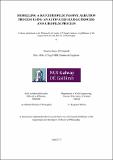| dc.contributor.advisor | Eoghan, Clifford | |
| dc.contributor.author | Noelle, Jones | |
| dc.date.accessioned | 2015-06-22T09:58:48Z | |
| dc.date.available | 2015-06-22T09:58:48Z | |
| dc.date.issued | 2015-05-29 | |
| dc.identifier.uri | http://hdl.handle.net/10379/5017 | |
| dc.description.abstract | Recently, mathematical modelling of wastewater treatment plants has become a widely used tool for planning, designing, optimising and evaluating wastewater treatment plants (WWTPs). While wastewater models can provide insights into plant upgrades, new plant designs, optimised operational regimes and enable discharge effluent limits to be met, they are not been widely applied, particularly in informing the development of new technologies or optimising small-scale WWTPs. This is frequently due to the significant resources necessary to develop calibrated models for individual wastewater treatment processes.
The pumped flow biofilm reactor (PFBR), a batch biofilm technology, is a recent example of a new technology targeted at urban areas of about 5000 persons or less. This biofilm-based passive aeration system has been shown to have potential as an energy efficient and low maintenance alternative for the treatment of municipal wastewater. However, the modelling of biofilm-based PAS can present challenges, particularly where new technologies are not easily simulated using existing commercial modelling software. As a relatively new technology a predictive model for the PFBR system has yet to be developed. Indeed for novel passive aeration systems in general, it can be time consuming and difficult to develop new models that accurately describe performance. Nevertheless, if the modeller is concerned only with simulating ¿macro¿ plant performance (e.g. key effluent concentrations and cycle analysis), it may be possible to model these technologies using 'surrogate' unit process systems (e.g. using an activated sludge process to model a biofilm process). While in practice biofilm systems may have been modelled as activated sludge systems, there has been limited research conducted on how such models can be systematically developed and what the merits or otherwise are of using activated sludge models as surrogates for biofilm systems.
The present investigation serves to investigate the possibility of (1) modelling the PFBR using an activated sludge object in GPS-X in order to quickly study the PFBR (2) predicting effluent results and contaminant concentration changes (nitrogen and organic carbon) during individual treatment cycles using the activated sludge object (3) modelling different operational scenarios and thus optimising operational efficiency and (4) modelling the PFBR using AQUASIM in order to study the cycle performance, biofilm thickness and biofilm composition of the PFBR.
The PFBR was modelled and calibrated at laboratory and field scale. In each case, after calibration, the models were verified using independent data. The models resulted in good predictions of effluent results and contaminant concentration changes (nitrogen and organic carbon) during individual treatment cycles and could thus be used for process optimisation; or eventually real time process simulation. In all cases there was limited data available due to minimal on site monitoring. This is typical of small scale systems and thus the study demonstrates that even limited monitoring, if strategically targeted, can lead to good model calibration.
The work done in this study has demonstrated that it is possible to model a novel wastewater technology using 'surrogate' processes in existing software. This has the potential to provide substantial benefits as such simulations can in turn can lead to cost savings during technology development and on-site operation. The calibrated model can enhance the understanding of the technology in question and thus lead to better design and more cost-effective wastewater treatment systems. The use of 'surrogate' unit processes as described in this research could be applied to other technologies to provide rapid performance simulation. Thus the study demonstrates simple approaches to modelling novel technologies where new technologies are not easily modelled using existing commercial modelling software. | en_US |
| dc.rights | Attribution-NonCommercial-NoDerivs 3.0 Ireland | |
| dc.rights.uri | https://creativecommons.org/licenses/by-nc-nd/3.0/ie/ | |
| dc.subject | AQUASIM | en_US |
| dc.subject | Batch biofilm reactor | en_US |
| dc.subject | Calibration | en_US |
| dc.subject | GPS-X | en_US |
| dc.subject | Passive aeration systems | en_US |
| dc.subject | Pumped flow biofilm reactor (PFBR | en_US |
| dc.subject | Wastewater treatment modelling | en_US |
| dc.subject | Wastewater treatment technology | en_US |
| dc.subject | Civil Engineering | en_US |
| dc.title | Modelling a batch biofilm passive aeration process using an activated sludge process and a biofilm process | en_US |
| dc.type | Thesis | en_US |
| dc.contributor.funder | Galway Mayo Institute of Technology, Galway, Ireland | en_US |
| dc.local.note | The work done in this study has involved the modelling and calibration of a new wastewater treatment technology known as the Pumped Flow Biofilm Reactor (PFBR) using surrogate unit objects in existing software. | en_US |
| dc.local.final | Yes | en_US |
| nui.item.downloads | 3825 | |


